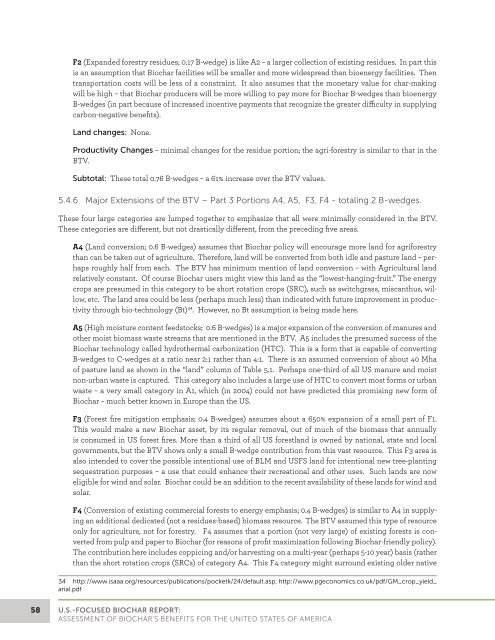U.S.-FocUSed Biochar report - BioEnergy Lists
U.S.-FocUSed Biochar report - BioEnergy Lists
U.S.-FocUSed Biochar report - BioEnergy Lists
You also want an ePaper? Increase the reach of your titles
YUMPU automatically turns print PDFs into web optimized ePapers that Google loves.
F2 (Expanded forestry residues; 0.17 B-wedge) is like A2 – a larger collection of existing residues. In part thisis an assumption that <strong>Biochar</strong> facilities will be smaller and more widespread than bioenergy facilities. Thentransportation costs will be less of a constraint. It also assumes that the monetary value for char-makingwill be high – that <strong>Biochar</strong> producers will be more willing to pay more for <strong>Biochar</strong> B-wedges than bioenergyB-wedges (in part because of increased incentive payments that recognize the greater difficulty in supplyingcarbon-negative benefits).Land changes: None.Productivity Changes – minimal changes for the residue portion; the agri-forestry is similar to that in theBTV.Subtotal: These total 0.76 B-wedges – a 61% increase over the BTV values.5.4.6 Major Extensions of the BTV – Part 3 Portions A4, A5, F3, F4 - totaling 2 B-wedges.These four large categories are lumped together to emphasize that all were minimally considered in the BTV.These categories are different, but not drastically different, from the preceding five areas.A4 (Land conversion; 0.6 B-wedges) assumes that <strong>Biochar</strong> policy will encourage more land for agriforestrythan can be taken out of agriculture. Therefore, land will be converted from both idle and pasture land – perhapsroughly half from each. The BTV has minimum mention of land conversion – with Agricultural landrelatively constant. Of course <strong>Biochar</strong> users might view this land as the “lowest-hanging-fruit.” The energycrops are presumed in this category to be short rotation crops (SRC), such as switchgrass, miscanthus, willow,etc. The land area could be less (perhaps much less) than indicated with future improvement in productivitythrough bio-technology (Bt) 34 . However, no Bt assumption is being made here.A5 (High moisture content feedstocks; 0.6 B-wedges) is a major expansion of the conversion of manures andother moist biomass waste streams that are mentioned in the BTV. A5 includes the presumed success of the<strong>Biochar</strong> technology called hydrothermal carbonization (HTC). This is a form that is capable of convertingB-wedges to C-wedges at a ratio near 2:1 rather than 4:1. There is an assumed conversion of about 40 Mhaof pasture land as shown in the “land” column of Table 5.1. Perhaps one-third of all US manure and moistnon-urban waste is captured. This category also includes a large use of HTC to convert most forms or urbanwaste – a very small category in A1, which (in 2004) could not have predicted this promising new form of<strong>Biochar</strong> – much better known in Europe than the US.F3 (Forest fire mitigation emphasis; 0.4 B-wedges) assumes about a 650% expansion of a small part of F1.This would make a new <strong>Biochar</strong> asset, by its regular removal, out of much of the biomass that annuallyis consumed in US forest fires. More than a third of all US forestland is owned by national, state and localgovernments, but the BTV shows only a small B-wedge contribution from this vast resource. This F3 area isalso intended to cover the possible intentional use of BLM and USFS land for intentional new tree-plantingsequestration purposes – a use that could enhance their recreational and other uses. Such lands are noweligible for wind and solar. <strong>Biochar</strong> could be an addition to the recent availability of these lands for wind andsolar.F4 (Conversion of existing commercial forests to energy emphasis; 0.4 B-wedges) is similar to A4 in supplyingan additional dedicated (not a residues-based) biomass resource. The BTV assumed this type of resourceonly for agriculture, not for forestry. F4 assumes that a portion (not very large) of existing forests is convertedfrom pulp and paper to <strong>Biochar</strong> (for reasons of profit maximization following <strong>Biochar</strong>-friendly policy).The contribution here includes coppicing and/or harvesting on a multi-year (perhaps 5-10 year) basis (ratherthan the short rotation crops (SRCs) of category A4. This F4 category might surround existing older native34 http://www.isaaa.org/resources/publications/pocketk/24/default.asp; http://www.pgeconomics.co.uk/pdf/GM_crop_yield_arial.pdf58U.S.-Focused <strong>Biochar</strong> Report:Assessment of <strong>Biochar</strong>’s Benefits for the United States of America
















